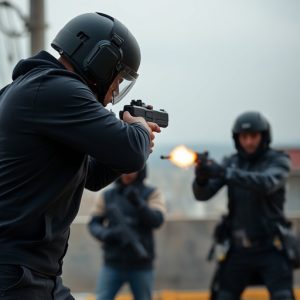Non-Lethal Weapon Training: Certifying Requirements, Maintenance, and Safety
Non-lethal weapon certification is crucial for buying and using devices like stun guns, tasers, or p…….
Non-lethal weapon certification is crucial for buying and using devices like stun guns, tasers, or pepper spray safely. Training includes handling, deployment, legal aspects, and key maintenance: battery care. Stun gun batteries require regular cleaning, optimal storage (3.7V, cool, dry), and adherence to manufacturer guidelines. To maximize lifespan, store in cool, dry conditions, use dedicated chargers (20-80% charge), inspect for damage or corrosion, and regularly test/calibrate. Proper battery maintenance ensures reliability during high-pressure situations, building trust in non-lethal force options.
In today’s world, understanding non-lethal weapon training certification is crucial for professionals aiming to enhance their capabilities while adhering to safety protocols. This comprehensive guide delves into essential aspects of obtaining and maintaining certification, focusing on key requirements, weapon selection, and practical tips. Learn how to choose the right non-lethal weapons, implement effective battery maintenance programs, maximize stun gun battery life, ensure regular testing and calibration, and navigate legal considerations for a successful certification journey.
- Understanding Non-Lethal Weapon Training Certification Requirements
- Choosing the Right Non-Lethal Weapons for Training
- Essential Components of a Comprehensive Battery Maintenance Program
- Maximizing Stun Gun Battery Life: Practical Tips and Tricks
- The Role of Regular Testing and Calibration in Ensuring Effectiveness
- Legal Considerations and Safety Protocols for Non-Lethal Weapon Certification
Understanding Non-Lethal Weapon Training Certification Requirements
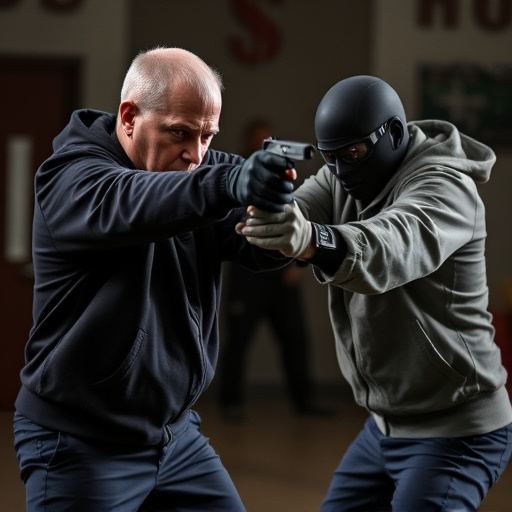
Non-lethal weapon training certification is a crucial step for individuals looking to purchase and use devices like stun guns, tasers, or pepper spray. The requirements vary by region, but they generally involve completing a comprehensive training course that educates users on the proper handling, deployment, and legal implications of these tools. Certification ensures that users understand how to maximize their effectiveness while minimizing risks.
One key aspect often covered in such training is battery maintenance, especially for stun guns. Learning how to maintain the stun gun battery life extends the lifespan of the device and ensures it’s ready when needed. Proper care includes regular charging, avoiding extreme temperatures, and understanding the specific guidelines provided by the manufacturer. This knowledge not only enhances safety but also guarantees the tool remains reliable in critical situations.
Choosing the Right Non-Lethal Weapons for Training

When selecting non-lethal weapons for training purposes, it’s crucial to balance effectiveness with safety. Stun guns, pepper spray, and tasers are popular choices, each with unique advantages. For instance, stun guns deliver a strong electric shock, rendering an attacker temporarily immobilized, while pepper spray causes temporary blindness and coughing fits. Tasers, on the other hand, use electrical pulses to disrupt muscle control.
Proper training should include learning how to maintain the equipment effectively. For example, understanding how to properly charge and store a stun gun battery is essential for its longevity. Regular cleaning and care instructions specific to each weapon are vital to ensure optimal performance and safety during simulations.
Essential Components of a Comprehensive Battery Maintenance Program
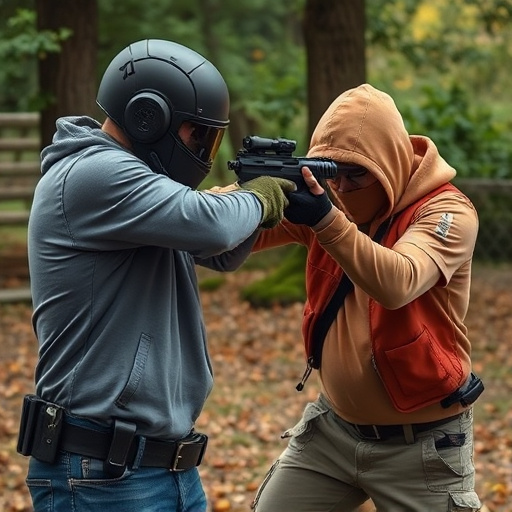
To ensure optimal performance and safety, a comprehensive battery maintenance program for stun guns is paramount. This involves several key components that work in harmony to prolong battery life and guarantee reliability when it matters most. Firstly, regular cleaning and inspection are crucial; removing any buildup or debris from the battery contacts and housing prevents short circuits and enhances conductivity. Additionally, proper storage plays a significant role; keeping the stun gun charged at an optimal level (typically around 3.7V) and storing it in a cool, dry place can significantly extend battery life between uses.
Furthermore, understanding the specific chemistry of your stun gun battery is essential. Most modern devices utilize lithium-ion batteries, known for their high energy density but requiring delicate handling to avoid damage or overheating. Regular monitoring of battery health through dedicated apps or indicators ensures that you replace the battery before its capacity diminishes significantly. This proactive approach combines with adherence to manufacturer guidelines for charging and storage protocols to create a robust battery maintenance regimen.
Maximizing Stun Gun Battery Life: Practical Tips and Tricks
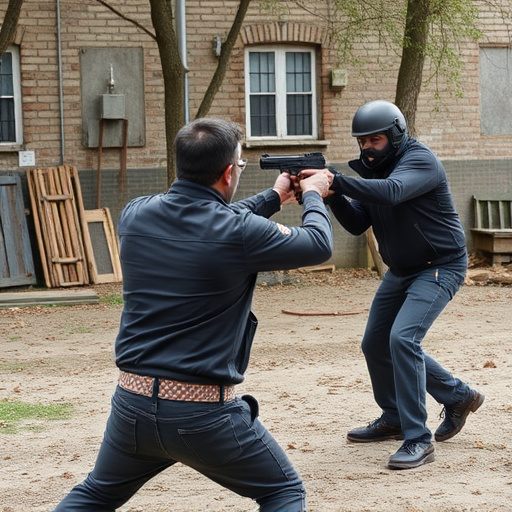
To maximize the lifespan of your stun gun’s battery, regular maintenance is key. Start by keeping the device in a cool, dry place, avoiding extreme temperatures that can deplete the battery faster. Many stun guns come with protective cases; ensure you store them within these cases when not in use. Avoid exposing the device to direct sunlight or leaving it in hot cars, as heat is an enemy of lithium-ion batteries, which are commonly used in stun guns.
Additionally, consider using a dedicated battery charger designed for your specific stun gun model. Overcharging can lead to reduced battery life, so always follow the manufacturer’s guidelines for charging. Avoid leaving your stun gun charged at 100% all the time; instead, aim for a balanced charge between 20-80%. This helps prolong the battery’s health and prevents it from reaching its maximum capacity too frequently. Regularly inspect the battery for any signs of damage or corrosion and address them promptly to maintain optimal performance.
The Role of Regular Testing and Calibration in Ensuring Effectiveness
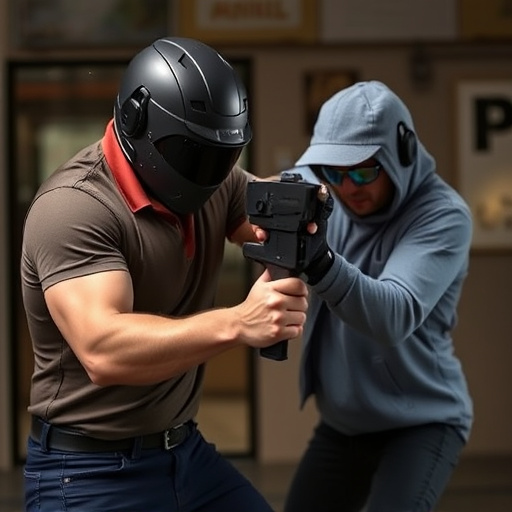
Regular testing and calibration are vital components in ensuring the effectiveness and reliability of non-lethal weapons, particularly stun guns. These devices rely on consistent performance to deliver a strong electric shock when needed, so proper maintenance is critical. One key aspect is understanding how to maintain stun gun battery life. Regular checks and calibrations can prevent premature battery drain and ensure the device will function as intended in high-pressure situations.
By following a structured testing regimen, users can identify any potential issues early on. This includes checking battery health, which involves monitoring voltage levels and current discharge rates. Calibration processes should be performed at regular intervals to maintain accuracy, ensuring the stun gun delivers the specified shock level required for effective incapacitation. Such proactive measures not only extend the lifespan of the equipment but also provide peace of mind for both operators and those they protect.
Legal Considerations and Safety Protocols for Non-Lethal Weapon Certification

Obtaining a non-lethal weapon certification involves navigating a web of legal considerations and safety protocols. Each jurisdiction has its own set of regulations dictating who can carry such devices, under what circumstances, and with what restrictions. Candidates must demonstrate proficiency in the safe handling, deployment, and deactivation of non-lethal weapons, such as stun guns or tasers. Understanding local laws is paramount to ensure compliance and avoid legal repercussions.
Safety protocols are integral to responsible non-lethal weapon certification. Training programs emphasize the importance of proper battery maintenance, especially for devices like stun guns that rely on electricity. Knowing how to maintain stun gun battery life, including charging instructions and storage guidelines, ensures the device is operational when needed. Adhering to safety protocols not only protects users but also fosters public trust in non-lethal force options as alternative means of self-defense or law enforcement intervention.
Obtaining a non-lethal weapon training certification is a comprehensive process that involves understanding legal requirements, selecting appropriate equipment, and mastering maintenance and safety protocols. By adhering to guidelines for battery care, such as maximizing stun gun battery life through practical tips, regular testing, and calibration, individuals can ensure their devices remain effective tools for self-defense or professional use. Remember, proper certification not only enhances safety but also empowers users to make informed decisions in critical situations.
